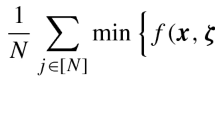Abstract
Model RB is a model of random constraint satisfaction problems, which exhibits exact satisfiability phase transition and many hard instances, both experimentally and theoretically. Benchmarks based on Model RB have been successfully used by various international algorithm competitions and many research papers. In a previous work, Xu and Li defined two notions called i-constraint assignment tuple and flawed i-constraint assignment tuple to show an exponential resolution complexity of Model RB. These two notions are similar to some kind of consistency in constraint satisfaction problems, but seem different from all kinds of consistency so far known in literatures. In this paper, we explicitly define this kind of consistency, called variable-centered consistency, and show an upper bound on a parameter in Model RB, such that up to this bound the typical instances of Model RB are variable-centered consistent.
Similar content being viewed by others
References
Bessiere, C. (2006). Constraint propagation, handbook of constraint programming (pp. 29–84).
Cai, S., Su, K., & Sattar, A. (2011). Local search with edge weighting and configuration checking heuristics for minimum vertex cover. Artificial Intelligence, 175(9–10), 1672–1696.
Cheeseman, P., Kanefsky, R., & Taylor, W. (1991). Where the really hard problems are. In Proceedings of IJCAI (pp. 163–169).
Dechter, R. (2003). Constraint processing. San Mateo, CA: Morgan Kaufmann.
Fan, Y., & Shen, J. (2011). On the phase transitions of random k-constraint satisfaction problems. Artificial Intelligence, 175, 914–927.
Freuder, E. C. (1982). A sufficient condition for backtrack-free search. Journal of the Association for Computing Machinery, 29(1), 24–32.
Gao, Y., & Culberson, J. C. (2007). Consistency and random constraint satisfaction models. Journal of Artificial Intelligence Research, 28, 517–557.
Gomes, C., & Walsh, T. (2006). Randomness and structures, handbook of constraint programming (pp. 639–664).
Janson, S., Luczak, T., & Rucinski, A. (2000). Random graphs. New York: Wiley.
Lecoutre, C. (2009). Constraint networks: Techniques and algorithms. New York: ISTE/Wiley.
Li, W. (2010). Logical verification of scientific discovery. Science China Information Sciences, 53(4), 677–684.
Liu, T., Lin, X., Wang, C., Su, K., & Xu, K. (2011). Large hinge width on sparse random hypergraphs. In Proceedings of the 22nd international joint conference on artificial intelligence (IJCAI’2011) (pp. 611–616).
Luo, J., & Li, W. (2011). An algorithm to compute maximal contractions for Horn clauses. Science China Information Sciences, 54(2), 244–257.
Mackworth, A. K. (1977). Consistency in networks of relations. Artificial Intelligence, 8, 99–118.
Mitzenmacher, M., & Upfal, E. (2005). Probability and computing. Cambridge, UK: Cambridge University Press.
Montanari, U. (1974). Networks of constraints: Fundamental properties and applications to picture processing. Information sciences, 7, 95–132.
Tsang, E. P. K. (1993). Foundations of constraint satisfaction. London and San Diego: Academic Press.
Xu, K. (2004). BHOSLIB: Benchmarks with hidden optimum solutions for graph problems. http://www.nlsde.buaa.edu.cn/kexu/benchmarks/graph-benchmarks.htm.
Xu, K., & Li, W. (2000). Exact phase transitions in random constraint satisfaction problems. Journal of Artificial Intelligence Research, 12, 93–103.
Xu, K., & Li, W. (2006). Many hard examples in exact phase transitions. Theoretical Computer Science, 355, 291–302.
Xu, K., Boussemart, F., Hemery, F., & Lecoutre, C. (2007). Random constraint satisfaction: Easy generation of hard (satisfiable) instances. Artificial Intelligence, 171, 514–534.
Acknowledgments
This research was partially supported by the National 973 Program of China 2010CB328103 and the National Natural Science Foundation of China 60725207 and 60973033.
Author information
Authors and Affiliations
Corresponding authors
Rights and permissions
About this article
Cite this article
Li, L., Liu, T. & Xu, K. Variable-Centered Consistency in Model RB. Minds & Machines 23, 95–103 (2013). https://doi.org/10.1007/s11023-012-9270-6
Received:
Accepted:
Published:
Issue Date:
DOI: https://doi.org/10.1007/s11023-012-9270-6




